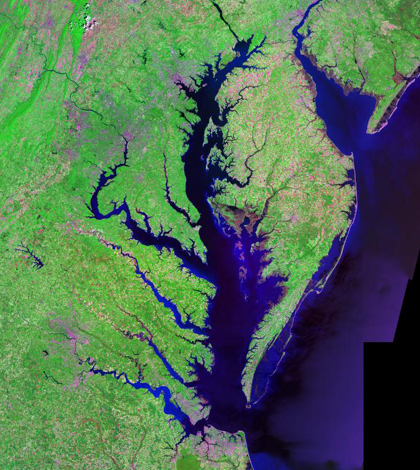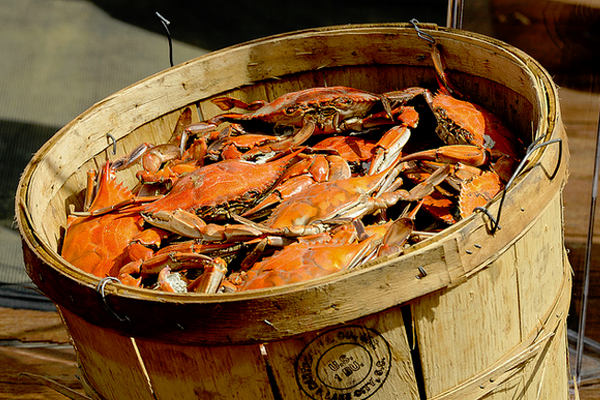Chesapeake Bay water quality remains poor, even as nutrient and sediment levels decline

An aerial view of Chesapeake and Delaware bays from the Landsat satellite (Credit: USGS, vis Wikimedia Commons)
The Chesapeake Bay just can’t catch a break. As if a recent spell of unusually high ice coverage wasn’t enough, most of the bay is still afflicted by poor water quality — even though long-term nutrient and sediment levels are declining, according a press release from the Chesapeake Bay Program.
Analysis of data from 2013 reveals that pollution flowing into the bay from nine of its major tributaries was below the 25-year average, which could be good news for its long-term health. However, from 2011 to 2013, the bay met less than a third of the water quality standards established to support plant and animal life.
The largest estuary in America, Chesapeake Bay has faced overfishing, rising temperatures, acidification, and habitat loss due to runoff pollution and other nutrient-loading contaminants. A growing hypoxic zone could lead to the end of blue crab harvest, one of the Bay’s three leading commercial fishing targets.
Management practices developed by the Chesapeake Bay Program and its partners have reduced loads of nitrogen, phosphorous and sediment flowing into the bay over the past year. But last year, the bay achieved two percent less of its water quality standards than the year before.

The Chesapeake blue crab — which turns reddish orange when cooked — could disappear from the bay within a century if water quality and fishing pressure don’t improve. (Credit: Maryland GovPics, via Flickr/CC BY 2.0)
Declines in the bay’s underwater grasses are likely a contributing factor to its diminishing health. Healthy grass beds provide habitat for young fish and other organisms, absorb excess nutrients, improve oxygen levels and reduce erosion. When mobile sediment clouds the water, grasses suffer. But with sediment levels decreasing, the grasses of Chesapeake Bay could recover, leading to healthier waters.
The Chesapeake Bay Program is pushing for further management practices that would help clean up the bay, including upgrades to wastewater treatment plants, more stringent emissions standards and reduced fertilizer use. For more information on management solutions or how to contribute, check out the Program online.
Top image: An aerial view of Chesapeake and Delaware bays from the Landsat satellite (Credit: USGS, via Wikimedia Commons)





0 comments